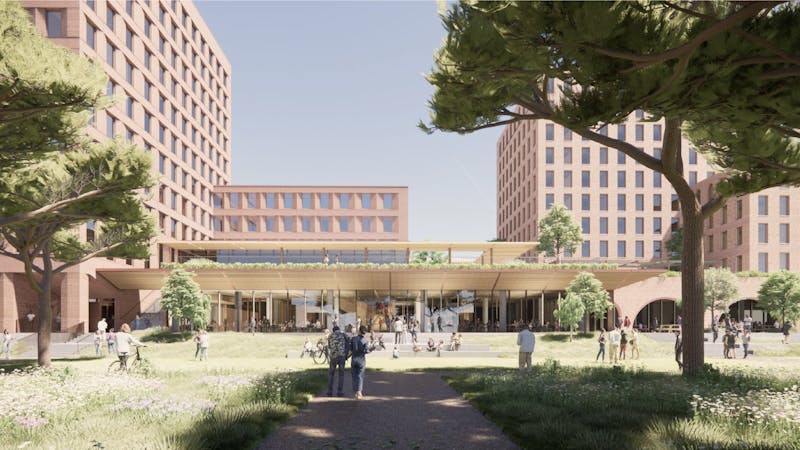Rice's recent AC energy use declines
For such an essential utility in an area like Houston, air conditioning remains generally unseen to the student body and noticed only during its absence, according to David McDonald, the senior business director for Rice University Housing and Dining.
Richard Johnson, the director of the Administrative Center for Sustainability and Energy Management, said the cost of air conditioning can be determined by measuring the amount of chilled water used to cool air in buildings plus the amount of electricity used to power pumps that circulate the water around campus.
Johnson said air conditioning composes a major portion of H&D's utility costs.
"If I look at [H&D's] total utility consumption, about a third is for chilled water," Johnson said. "When you work in the electricity, it's probably upward of 35 to 40 percent. Across campus, [H&D] represents a little over more than 20 percent of total energy costs, with the lab buildings being the biggest consumers."
According to Johnson, a 10-year process of transitioning from a two-pipe to a more efficient four-pipe air-conditioning system finished this past summer. The new Hanszen College building was the last remodeled residential area.
"With a two-pipe system and from a student perspective, you wouldn't have any control over AC other than whether it was on or off," Johnson said. "So the way students would regulate it was by opening and closing windows, which causes both energy to be wasted and the humidity from outside to damage the interior."
McDonald said that besides making the air-conditioning system itself more flexible over the past summers, H&D has also installed thermostats with limited temperature ranges.
"We've retrofitted nearly all the room thermostats with limiters that adhere to [the American Society of Heating, Refrigeration and Air-Conditioning Engineers] policies of 74 to 78 [degrees Fahrenheit] for cooling and 68 to 72 [degrees Fahrenheit] for heating," McDonald said. "We had to tear open each building down to the chassis to get the pipes in over the summer. We would take an entire building offline and literally gut it open from the day the students leave. But by the first week of August, it's all put back together, and students don't even know the difference, except that there are thermostats that work."
McDonald said that concerns other than AC are taking precedent at many residential colleges.
"At [Duncan and McMurtry], the AC actually turns off when the windows are opened," McDonald said. "For the colleges as a whole, though, the focus right now is not so much on the air-conditioning system itself, but on the building envelopes, where we're losing energy through windows, frames and insulation.
Johnson said measuring the changes in air-conditioning costs is difficult for H&D areas because many of the residential colleges are measured collectively.
"For the [residential colleges], with the exception of the newer McMurtry and Duncan Colleges, there are only a few master meters, where most of the students are measured as one big customer," Johnson said.
According to Johnson, despite the higher temperatures of the last few years combined with the heavier usage of residential colleges during the summer, more efficient AC systems have still caused per-capita chilled water consumption to significantly drop compared to that of the 2003-2004 baseline. He said this decrease in consumption can be attributed not only to new AC systems, efficient construction and replacement of thermostats, but also to student involvement.
"H&D and FE&P [can] put buildings into setback or shutdown settings during winter break, which saves energy," Johnson said. "H&D has also been proactive in pursuing energy efficiency projects, and I would say that there's more of a culture of conservation amongst students now."
Susann Glenn, the manager of communications for Facilities Engineering and Planning, said that even in cases where components of the air-conditioning system cannot be fully optimized, there are ways to compensate for its energy consumption.
"South Plant, which was built in 2008, is such a consumer of energy that it was not feasible to build it to [Leadership in Energy and Environmental Design] certification standards," Glenn said. "There are many green features [for buildings that are not LEED certified] such as photovoltaics on the diesel generators that provide power, a vegetative green roof and a large pipe collecting air condensate from the [BioScience Research Collaborative] that feeds into the cooling tower."
McDonald said that even though many of the improvements made to the air conditioning are technological, students can make a significant impact on air-conditioning costs too.
"We rely on students because while we can give you the tools and the infrastructure, how you use it is where the savings come in," McDonald said. "AC makes up approximately one-sixth of room fees, which is about $4,200 per semester."
Johnson said students have a financial incentive to reduce their air-conditioning costs and many ways to do so too.
"While obviously [student] housing bills are not just based on energy usage, part of it is dependent on the price of chilled water, so how you choose to set the AC will affect how you or others at Rice will pay," Johnson said. "Keeping the AC from 74 to 78 [degrees] is a first good step, as well as not turning on the AC and opening up the windows at the same time. If you're going to leave the room for any significant amount of time, just turn it off and lower to shades to prevent it from becoming too hot."
Sid Richardson College freshman Daniel Zhang said he would like more specific ways of measuring use of air-conditioning by individual colleges or rooms.
"It would be cool if our cost to our room was directly correlated with how much we would pay for housing," Zhang said. "But that might be really hard to implement because it would require installing a lot of different meters. Also, upgrading certain features such as insulation by tearing apart buildings costs a lot of money, which for me, leads to the question of how many years [it would] take to pay back the money it took to install the new equipment."
Brown College freshman Joel Thompson said he would like more transparent ways of distributing air conditioning costs among students.
"It's easy to ... cool the room below the 72 [degrees Fahrenheit] limit, and students who do this are likely the biggest wasters of AC money," Thompson said. "I would be more likely to cut down on AC use if the cost savings were factored directly into student housing costs."
More from The Rice Thresher

Rice announces Chao College as 12th residential college
Rice announced that the 12th residential college will be named Ting Tsung and Wei Fong Chao College Aug. 19. The college, set to open in fall 2026, will contain nearly 300 on-campus beds.
Dining access fund announced following on-campus unlimited meal swipes
Rice announced new food assistance programs on Tuesday to account for the controversial change in the on-campus meal swipe plan.

Rice disaster prediction model discussed at hearing on deadly Central Texas floods
The House and Senate Select Committees on Disaster Preparedness and Flooding held a hearing on July 31 in Kerrville to address the deadly July 4 flooding in Central Texas. The flooding along the banks of the Guadalupe River killed 108 people, including 37 children. In the charged hearing, Texas lawmakers and flood survivors criticized the local response to the disaster.


Please note All comments are eligible for publication by The Rice Thresher.